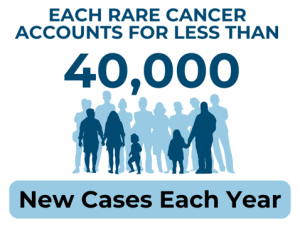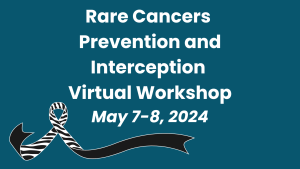Date Posted, by DCP Staff
At the Rare Cancers Prevention and Interception workshop this year, cancer researchers from across the United States, Canada, and the United Kingdom and from across disciplines sought to address many of the issues that can hamper research progress for these diseases.
Despite the name, rare cancers exact a high human toll, accounting for nearly one-fourth of all cancer deaths in the United States each year. “Rare” cancers affect fewer than 40,000 people annually. In adults, many familiar cancers fall into the rare category, including ovarian, brain, and esophageal cancers, Hodgkin lymphoma, and testicular and stomach cancers. All pediatric cancers are considered rare.

The pervasive impact of rare cancers, along with the Biden Cancer MoonshotSM directive to at least halve the nation’s cancer death rate within the next 25 years, has spurred momentum in the scientific community to find more ways to prevent or intercept these cancers before they take hold.
Conference speakers and attendees spoke to improving ways of sharing knowledge and data between investigators, clinicians, and patient advocates; addressing the lack of clinical trials specific to rare cancer prevention; and identifying research gaps and emerging opportunities in the field. Participants were also encouraged to explore important and provocative research questions that could lead to better ways to intercept or interrupt the progression of early cell changes that lead to cancer, and ultimately prevent these rare cancers from occurring.
The National Cancer Institute (NCI) and the Department of Defense (DoD) jointly sponsored the two-day virtual conference in May. The DoD oversees the Congressionally Directed Medical Research Programs (CDMRP), including a rare cancers research program, as the military population experiences a disproportionately high number of rare cancers.
Setting the stage
The NCI and other institutes within the National Institutes of Health conduct a number of research programs evaluating rare cancers in both children and adults, including the Natural History Study, which follows people with rare conditions to see how cancers develop, and the collaborative efforts of the NCI-funded Children’s Oncology Group and European Cooperative Study Group for Pediatric Rare Tumors (ExPert consortium) partners in Europe. Also, the Childhood Cancer Data Initiative houses molecular sequencing data from more than 3,000 young people with rare tumors, to date, as investigators continue to collect data from the U.S. and around the globe. The NCI Center for Cancer Research heads the My Pediatric and Adult Rare Tumor Network (MyPART), which is focused on treatments.
The relatively small number of patients affected by a rare cancer diagnosis, researchers said, pose many overlapping research challenges. Natural history studies on rare diseases, such as those conducted at the NIH Clinical Center, are informative to comprehensively describe a condition by collecting clinical, pathologic, imaging, and genetic data, but larger numbers of patients and long-term follow-up are needed to effectively test potential therapies or prevention approaches.
In addition, tracking the natural pathway or course of disease progression in rare cancers can be challenging when patients receive care in a variety of settings, making it difficult to centralize efforts such as collecting clinical and treatment information.

Using lessons learned from the discovery and long-term follow up of patients with the highly penetrant hereditary Li-Fraumeni cancer predisposition syndrome, Payal Khincha, M.B.B.S., Lasker Clinical Research Scholar in NCI’s Division of Cancer Epidemiology and Genetics (DCEG), and her colleagues identified an approach that could identify early-stage cancers. Her team’s research contributed to the development of updated surveillance protocols involving imaging, blood tests, and physical exams for patients with Li-Fraumeni syndrome that can detect cancer early.
“We need to look across the commonalities seen in all these cancers,” said Khincha, underscoring the importance of multidisciplinary collaboration and data sharing across community-, academic-, and federal-research sites studying and treating rare diseases.
It is essential to ramp up efforts for the prevention of rare cancers and raise awareness about rare cancer research in the prevention community. There is a need to pinpoint knowledge gaps and opportunities for prevention research as well as to identify rare cancers with underlying mechanisms that can be addressed through cancer preventive interventions, emphasized Altaf Mohammed, Ph.D., Program Director, and Robert Shoemaker, Ph.D., Chief of the Chemopreventive Agent Development Research group in NCI’s Division of Cancer Prevention.
Models for prevention
One successful model of collaborative prevention is the National Cancer Institute’ recently unveiled Cancer Prevention Clinic for groups at high risk of cancer – a collaboration between the Division of Cancer Prevention, the Center for Cancer Research, and DCEG. The clinic conducts research in cancer prevention, early detection and screening. “By combining experts seeking the ‘why’ in cancer using epidemiology and genetics research, the ‘how” from basic and preclinical research and using the “bench-to-bedside” approach from our clinical oncology researchers, we are primed to overcome the gaps that occur when those connections are missing,” said Sharon Savage, M.D., clinical director of DCEG and co-director of the Cancer Prevention Clinic.
Early phase trials are underway that seek to immunize high-risk individuals against cancers associated with Lynch syndrome, the most common cause of hereditary colorectal cancer. People who inherit the condition have an estimated lifetime risk as high as 80% for developing one of these malignancies, as well as an above-average risk for cancers arising in other organs, often at an early age, and regardless of race or gender.
Eduardo Vilar-Sanchez, M.D., Ph.D,. chair of the department of clinical cancer prevention and trial lead at MD Anderson Cancer Center described one of the experimental vaccines that uses 209 proteins over-expressed in cancer cells, but rarely seen in healthy cells. “Still in phase1/phase 2 trials, the prime-and-booster-shot protocol appear promising to train the immune system to recognize the early signals of tumor development and to disrupt them early on to achieve immunity.”
A newly launched international collaborative effort will be testing the direct and indirect effects of the diabetes drug, metformin, on cancer incidence and progression in people with Li-Fraumeni syndrome. By age 30, at least half of all people with LFS are expected to develop some type of malignancy.
“It’s a fantastic international collaboration,” said Sarah Blagden, M.D., Ph.D., professor of medical oncology at Oxford and the trial’s lead investigator, describing the multi-institutional effort, which has an enrollment goal of 224 adults in the United Kingdom; 310 adults in the United States; 200 adults and children in Germany; and 200 children in Canada.
The Metformin in Li Fraumeni Syndrome (MILI) trial, currently enrolling in the UK, seeks to address questions such as metformin’s ability to prevent or delay cancer, as well as shed light on the molecular events that could provide opportunities to intervene. But investigators also hope the study will help understand carcinogenesis in LFS, and provide some answers sooner than later.
“MILI’s focus on a high-risk population is expected to yield answers more quickly than traditional clinical trials whose design requires thousands of patients to assess clinical benefit,” said Blagden.
The path forward
Workshop participants agreed that collaboration and access to research resources, including data and specimens, were critical to advance research in rare cancer prevention and interception. Forming collaborations and networks to capture as many affected patients as possible and designing trials to be robust in capturing critical data to answer questions using informative end-points was also emphasized.
Other recommendations included devising strategies across cancers, leveraging immunoprevention strategies and biomarkers, prioritize cancers for prevention and interception efforts, enhance advance investigation by bringing interested partners together, promote academic research support and multi-institutional collaborations, and facilitate data sharing. Networking among federal and academic researchers to increase resource sharing and to avoid duplicating efforts. They further suggested reaching out for possible collaborations with larger non-profits, such as the American Cancer Society or Prevent Cancer Foundation and to consider working with pharmaceutical companies with rare tumor sections and strong ties to patients with rare cancers.
One indisputable element in building patient cohorts for research in rare cancers remains patient advocacy engagement, according to Brigitte Widerman, M.D., chief of the NCI CCR Pediatric Oncology Branch. “Our NIH tumor clinics provide insight into these cancers, but we need to accrue sufficient patient numbers” with advocates’ help to do effective clinical research, she said.
Workshop participants agreed patient advocacy groups play a vital role in advancing research throughout the research process. Rare cancer patient advocates can be part of the grant application process, the researchers said, and they should be part of the design development for promising new drugs or prevention strategies that could ultimately be proposed to the Food and Drug Administration approval. “Although advocacy, patient engagement, and technical expertise are critical to making progress,” said Widemann, “a community of disease champions may be the most important accelerator.”
If you would like to reproduce some or all of this content, see Reuse of NCI Information for guidance about copyright and permissions. Please credit the National Cancer Institute as the source and link directly to the blog post using the original title, for example: "Targeting Prevention to Reduce the High Human Toll of Rare Cancers was originally published by the National Cancer Institute." For questions, contact us at CancerPreventionBlog@mail.nih.gov.
